Benutzer-Werkzeuge
Seitenleiste
Inhaltsverzeichnis
Seven Metamorphoses of the "Scientific-Artistic-Transcendental" Pixel – "[Digital] [Neo-]Pointillistic" CyberneticArt Point of View
bcd CyberneticArt team (Königswinter_Berlin_Zagreb):
Miro A. Cimerman & Dunja Donassy-Bonačić
Following our bcd CyberneticArt team contribution at the last year Virtual Exhibition @ VCFB 2020 (Details Page) we continue this year @ VCFB 2021 with the revealment of the newest exploration into digitality, by means of “Hidden [Digital] Data Structures” (© bcd team; WIP), of our CyberneticArt oeuvre and accompanying media archeological digitalization of our CyberneticArt Archive. Our principal interest was, and still is, in deciphering complex dynamic structures of "behaviour" of the Galois Fields, in particular GF(2), through visual and audible effects by usage of interactive [digital] computer systems applying the "Hidden [Digital] Data Structures Method" (© bcd team).
(bcd CyberneticArt team oeuvre:Artists' Talk/Lecture @ ZKM 2019
accompanying video)
This year premier Interactive Virtual Exhibition (jubilee; a 50th anniversary of bcd team) comprises a thematic representative sample of our CyberneticArt works created with many generations of [un]conventional [Digital] Computer Systems we used and/or own[ed]/devised in our art, design and research projects by various modalities (more about). It is focused primarily on [Téchne-Lógos] Pixel and based on our "[Digital] [Neo-]Pointillistic“ CyberneticArt Point of View Principle (© bcd team), showing hitherto our intensions in introducing and improving "pixel processes", "pixel graphics", "pixel sculptures", and "pixel installations". We tried to find “interconnecting link[s]” for all of our artworks. In “media archeological” approach, we used a “[sub]atomization” of each single artwork analyzing the key fundamental factors. One of our discoveries was: PIXEL = well known as any of the very small discrete elements (dots) that together constitute an image (form the picture), as on a television or digital screen, computer monitor, etc.
Starting point (Static Scientific Pixel) is to be found in the then (mid 1960ies) newly established “Laboratory for Cybernetics”, organizationally located in the “Department for Nuclear Physics” of the Croatian National Research “Institute Ruđer Bošković” (IRB | Zagreb). There, a historical encounter brought artists and scientists together. The organizers of [New] Tendencies(*), in their search for scientists and desire for creative cooperation in the Program “Computers and Visual Research”, came in contact with nearly 30-year-old Vladimir Bonačić (member of the Laboratory, already a respected scientist and computer expert, later in 1971 founding member of bcd CyberneticArt team) and aroused his interest and motivation. Already in his premier artwork (“IRB 8-9” in 1968 @ t4 exhibition “Computers and Visual Research”) Vladimir transformed Static Scientific Pixel and invented out of it Proto-[Intelligent] [Interactive] Dynamic Graphic Artistic Pixel for use in art (more about).
(*)Link [New] Tendencies:
"bit INTERNATIONAL"@ZKM 2008/2009
Accompanying Trailer
In the next year (1969), for the second part of the t4 exhibition “Computers and Visual Research”, Vladimir applied newly invented Dynamic Graphic Artistic Pixel for use in art(more about). He presented series of 15 own artworks and was awarded with the recognition prize of the International Art Jury of t4 (among others Umberto Eco as juror). Following years brought hitherto numerous artworks of Vladimir alone and together with bcd CyberneticArt team, resulting in additional pixel transformations and further Pixel Metamorphoses. The culmination was already in 1980ies with the invention of [Intelligent] [Interactive] Timeless & Spaceless Transcendental Pixel, by bcd CyberneticArt team, thus concluding the Seven Metamorphoses in the complete CyberneticArt œuvre (more about).
We show selection of some typical examples for each Metamorphosis depicting characteristics of each pixel type. The (7) Seven Metamorphoses are chronologically and thematically ordered from Metamorphosis of Static Scientific Pixel into:
| (1st) | ⇒ Proto-[Intelligent] [Interactive] Dynamic Graphic Artistic Pixel |
| (2nd) | ⇒ [Interactive] Monochrome Bulb plain or + Color Film/Glass Visual Pixel |
| (3rd) | ⇒ [Interactive] Monochrome Milky Bulb Public Urban Space Visual Pixel |
| (4th) | ⇒ [Interactive] Glow Lamp Visual Pixel |
| (5th) | ⇒ [Interactive] Monochrome Bulb+Color Glass Proto-Audio&Visual Pixel |
| (6th) | ⇒ Proto-[…] […] LED (point, line, suface, space) Visual Pixel |
| (7th) | ⇒ Proto-[…] […] Timeless & Spaceless Transcendental Pixel |
(1st) Metamorphosis
⇒ Proto-[Intelligent] [Interactive] Dynamic Graphic Artistic Pixel
 Men & Machine visual on-line communication with minicomputer PDP 8 (DEC) connected via A/D and D/A converters to the Light Pen System & oscilloscope for displaying “pixel” graphics on the CRT screen. Middle (from left): TTY, PDP 8, A/D and D/A converters, oscilloscope with CRT screen, light pen stylus. The System was constructed in mid 1960s at The Laboratory for Cybernetics (IRB | Zagreb) and used for scientific research, mainly in nuclear spectroscopy (Leftmost: Van de Graaff experiment, 6Li+3He⇒p+a+a, 3.0 MeV, 35.7o, -37.5o; illustration of Static Scientific Pixel), but also by Vladimir Bonačić for art purposes in his pioneering use of “Computers and Visual Research” since 1968 onward (Rightmost: “IRB 8-9, V.B. 1968”; illustration of Dynamic Graphic Artistic Pixel).
Men & Machine visual on-line communication with minicomputer PDP 8 (DEC) connected via A/D and D/A converters to the Light Pen System & oscilloscope for displaying “pixel” graphics on the CRT screen. Middle (from left): TTY, PDP 8, A/D and D/A converters, oscilloscope with CRT screen, light pen stylus. The System was constructed in mid 1960s at The Laboratory for Cybernetics (IRB | Zagreb) and used for scientific research, mainly in nuclear spectroscopy (Leftmost: Van de Graaff experiment, 6Li+3He⇒p+a+a, 3.0 MeV, 35.7o, -37.5o; illustration of Static Scientific Pixel), but also by Vladimir Bonačić for art purposes in his pioneering use of “Computers and Visual Research” since 1968 onward (Rightmost: “IRB 8-9, V.B. 1968”; illustration of Dynamic Graphic Artistic Pixel).
[text will be updated]
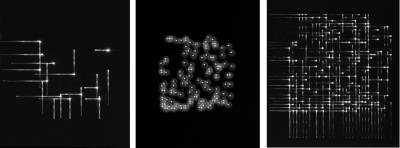 Illustration of Dynamic Graphic Artistic Pixel:
Illustration of Dynamic Graphic Artistic Pixel:
Details from "PLN Series, V.B. 1969" @ t4 Exhibition “Computers and Visual Research”
[text will be updated]
(2nd) Metamorphosis
⇒ [Interactive] Monochrome Bulb plain or + Color Film/Glass Visual Pixel
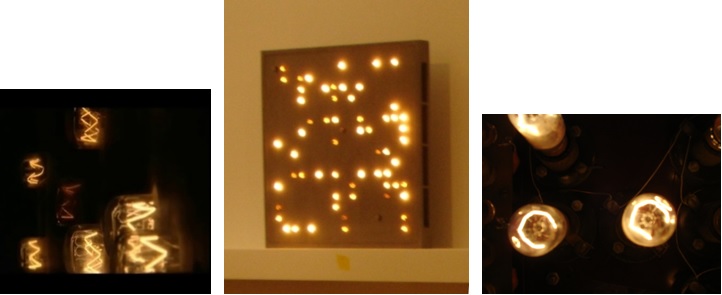 Monochrome Bulb (plain). "Random 63, V.B. 1969"
[text will be updated]
Monochrome Bulb (plain). "Random 63, V.B. 1969"
[text will be updated]
 Monochrome Bulb + Color Film. "Dynamic Object DIN. GF 100, V.B. 1969"
Monochrome Bulb + Color Film. "Dynamic Object DIN. GF 100, V.B. 1969"
[text will be updated]
(3rd) Metamorphosis
⇒ [Interactive] Monochrome Milky Bulb Public Urban Space Visual Pixel
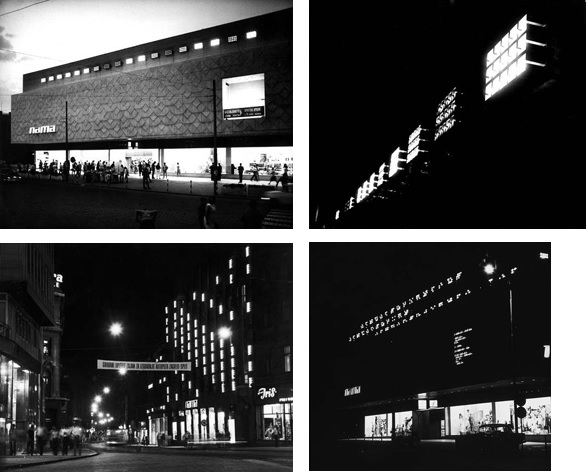 "Pixel Installation" in Public Urban Space (by V. Bonačić)
"Pixel Installation" in Public Urban Space (by V. Bonačić)
premier exhibited at tendencies 4, Zagreb 1969.
(DIN. PR 18, V.B. 1969, Kvaternik Square, Zagreb; upper left and right: detail)
followed by two other "Pixel Installations" in Public Spaces, Zagreb until 1971
(lower left: DIN. PR 10, 1971, NaMa Ilica, Zagreb)
(lower right: DIN. PR 16, 1971, NaMa Kvaternik Square, Zagreb).
[text will be updated]
(4th) Metamorphosis
⇒ [Interactive] Glow Lamp Visual Pixel
 Left: "Dynamic Object GF.E 16 S, V.B. 1969-1970"
Left: "Dynamic Object GF.E 16 S, V.B. 1969-1970"
Middle: Insight into "Dynamic Object GF.E 16 S, V.B. 1969-1970"
Right: "Dynamic Object GF.E 16 NS, V.B. 1969-1970"
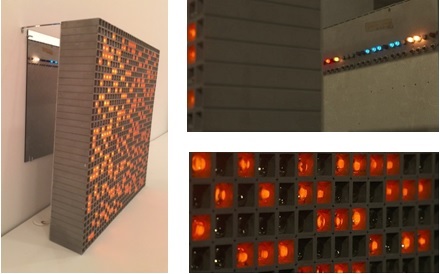 "Dynamic Object GF.E 32 NS, V.B. 1969-1970", Interactive CyberneticArt "Glow Lamp Visual Pixel Installation" by bcd team. Recently: at Cleveland's Triennial "FRONT International" (July 14 - September 30, 2018), and ZKM's "Writing the History of the Future" (23.02.2019 - 09.01.2022), and ZDF’s Virtual Museum, Digital Art Hall, ZDFmediathek “Computable – Incomputable” (30.10.2020 - 30.09.2021).
"Dynamic Object GF.E 32 NS, V.B. 1969-1970", Interactive CyberneticArt "Glow Lamp Visual Pixel Installation" by bcd team. Recently: at Cleveland's Triennial "FRONT International" (July 14 - September 30, 2018), and ZKM's "Writing the History of the Future" (23.02.2019 - 09.01.2022), and ZDF’s Virtual Museum, Digital Art Hall, ZDFmediathek “Computable – Incomputable” (30.10.2020 - 30.09.2021).
Link ZDF Virtual Museum
[text will be updated]
(5th) Metamorphosis
⇒ [Interactive] Monochrome Bulb+Color Glass Proto-Audio&Visual Pixel
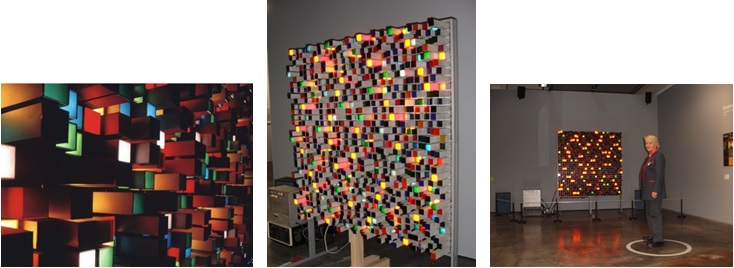 Left: "Dynamic Object GF.E 16,4 NS C M, V.B. 1969-1971". Detail, Front Side
Left: "Dynamic Object GF.E 16,4 NS C M, V.B. 1969-1971". Detail, Front Side
Middle: "Dynamic Object GF.E 16,4 NS C M, V.B. 1969-1971" @ Exhibion ZKM 2008-2009
Right: "Dynamic Object GF.E 16,4 NS C M, V.B. 1969-1971" @ Exhibion ZKM 2008-2009.
The visual and audible patterns, the appearance of their combinations, the rhythm of the change and the surround sound distribution originate from the same information source (Galois Fields) and are thus intrinsically interwoven.
Four independent acoustic channels with 4 loud-speakers (“QuadroSound”) make it possible to experience and immerse spectators into “Dynamic Acoustic & Visual Space” – “Listen Pictures & See Music” performance.
[text will be updated]
(6th) Metamorphosis
⇒ Proto-[Intelligent] [Interactive] LED (point, line, suface, space) Visual Pixel
![]() The visualization of “Hidden [Digital] Data Structures” of the Galois Fields (GF) is a problem of some complexity. The Interactive LED Pixel sculpture “Dynamic Line 64” renders visualy the “dynamic interaction” of three GFs of the degree 2xx64 and smaller. The same pattern in the GFs will repeat after five billion years. Successive elements from three Galois Generators (GGs) are produced by the program residing in the memory chips and executed in real time by the Micro Computer System MCS-80 (based on Intel’s 8080A processor), all of them placed on the single board of Intels System Development Kit 80 (SDK 80). It carries basic chips and provides enough place for extension chips and additional small amount of electronics. [text will be updated]
The visualization of “Hidden [Digital] Data Structures” of the Galois Fields (GF) is a problem of some complexity. The Interactive LED Pixel sculpture “Dynamic Line 64” renders visualy the “dynamic interaction” of three GFs of the degree 2xx64 and smaller. The same pattern in the GFs will repeat after five billion years. Successive elements from three Galois Generators (GGs) are produced by the program residing in the memory chips and executed in real time by the Micro Computer System MCS-80 (based on Intel’s 8080A processor), all of them placed on the single board of Intels System Development Kit 80 (SDK 80). It carries basic chips and provides enough place for extension chips and additional small amount of electronics. [text will be updated]
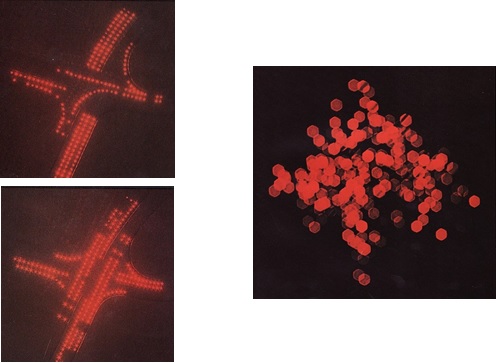 Model: Traffic Control, 1975 (driven by Single Board Computer) + "Object in Space", 1975 (ditto.)
[text will be updated]
Model: Traffic Control, 1975 (driven by Single Board Computer) + "Object in Space", 1975 (ditto.)
[text will be updated]
(7th) Metamorphosis
⇒ Proto-[Intelligent] [Interactive] Timeless & Spaceless Transcendental Pixel
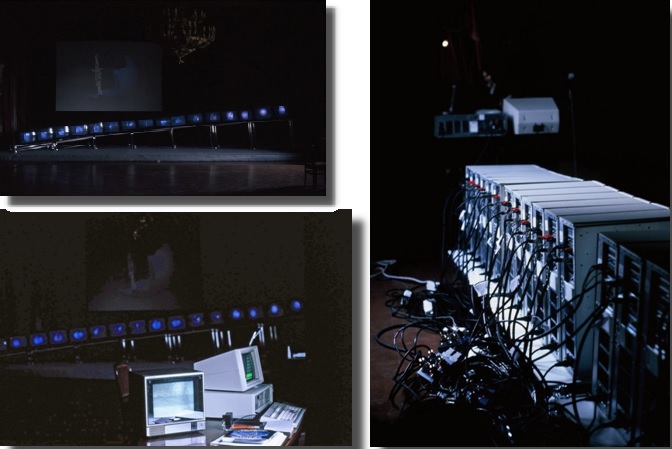 INSTANTANEOUS, interactive CyberneticArt "Transcendental Pixel Installation" by
INSTANTANEOUS, interactive CyberneticArt "Transcendental Pixel Installation" by
bcd team (1987), is an “impregnable unity” established between sixteen COMPAQ Deskpro 386 computers linked via LAN network (Novell NetWare) into the “dematerialized work of art” emulating on-line the “transcendental” Galois Field[s] in real-time. Two additional COMPAQ Deskpro 386 computers have been responsible for generation of the Galois Fields, operation of the network, the long-term memory, real-time scheduling of 16 parallel processors using “intelligent heuristic methods” and the interface with a graphical data-base (corresponding to the then PAL TV-broadcasting standard; different TV-standards, such as SECAM or NTSC including HDTV, could also be used with minor adaptations).
Exclusive world premier exhibition was held at Academia Nationale dei Lincei, Rome, 1987 under the auspices of UNESCO and European Academy of Arts, Sciences, and Humanities on the occasion of The International Colloquium “The Scientific Dimension of Cultural Development”. Reprint of the accompanied paper “A Transcendental Concept for Cybernetic Art in the 21st Century”, published in LEONARDO, Vol. 22, No. 1, pp. 109-111, 1989, will be on disposal on demand for VCFB 2021 together with associated documentation “bcd Visions for Cybernetic Art” (published by Paris Art Center and European Academy of Arts, Sciences and Humanities, autumn 1987), site specific photo documentation of the exhibition, and short video by France [Régions] 3 (FR3) depicting Deskpros 386 "performing" VR “motion without moving”.
[text will be updated]
——-
N. B.
Development and preparation of this Interactive Virtual Exhibition, with focal point on digitality and digitalization, was partially supported by the Grant »Module D: Digital Exchange Formats« as Partial Program of »New Start for Visual Artists« of the Association of German Artists e.V. Berlin in the framework of Federal Program NEW START CULTURE by Federal Government Commissioner for Culture and the Media.

Virtueller Ausstellungstisch
Anwesenheitszeiten
| Tag | Uhrzeit |
|---|---|
| Samstag | 12:00 - 14:00 |
| Samstag | 15:00 - 17:00 |
| Samstag | 18:00 - 20:00 |
| Sonntag | 11:00 - 13:00 |
| Sonntag | 14:00 - 17:30 |

